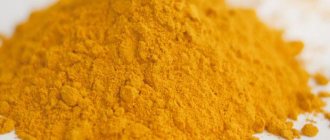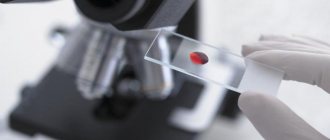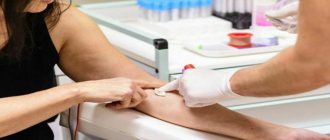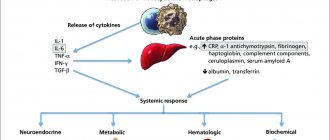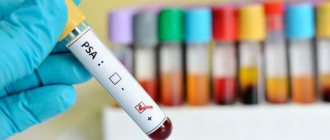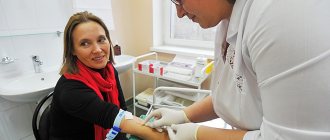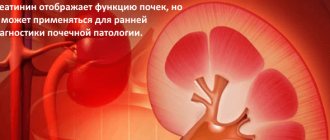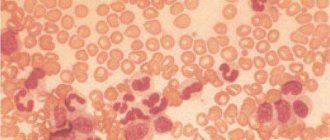What is direct and indirect bilirubin in the blood, and what is it responsible for?
- At the stage of red blood cell renewal, the bile pigment bilirubin is produced in a chain of biochemical processes.
- Primary bilirubin is called indirect or free . In this state, upon contact with liquid, the pigment retains its integral structure, but is highly soluble in fats. Indirect bilirubin is toxic and has an adverse effect on all body systems.
- Thanks to albumin proteins, indirect bilirubin moves to the liver and forms a new, safe organic compound. The dissolvable form of the pigment is called direct bilirubin. Thanks to bile, it enters the intestinal flora and, after a series of chemical reactions, is excreted in the stool. In the absence of pathologies, bilirubin is within normal limits and does not pose a threat to the body.
What is bilirubin
This is the name of the breakdown product of hemoglobin, cytochrome and myoglobin - heme-containing proteins. The formation of this bile pigment occurs in the liver. The entire process of its metabolism includes several stages:
- With the bloodstream, the pigment is transferred to the liver using a carrier - the protein albumin, which binds this toxic compound.
- Bilirubin is released on the surface of hepatocytes. Here it enters the liver cells, where it binds to glucuronic acid. The toxicity of the enzyme disappears, and it can already dissolve in water and be excreted with bile from the body.
- Next, the pigment enters the intestines, is transformed into urobilinogen, and is then excreted naturally along with feces.
- A small part of the enzyme is absorbed and enters the bloodstream. These residues are filtered by the liver and excreted in the urine.
If a failure occurs at any stage, the blood begins to accumulate this pigment. It exhibits its toxic properties, which is why internal organs suffer. Taking into account the characteristics of the metabolic process, bilirubin is divided into:
- Indirect (unbound, free). This is the breakdown product of heme substances. It is toxic and easily passes through the cell membrane. Responsible for the delivery of bilirubin to the liver, where it is neutralized.
- Direct (connected). This is already non-toxic bilirubin, which is formed in the liver and is subsequently excreted in feces. This type of enzyme is involved in the formation of bile.
Without taking into account these fractions, the level of total bilirubin in a person is determined, since it increases with an increase in any of the components. In general, this pigment acts as the main cellular antioxidant - a substance that binds free radicals. Thus, bilirubin slows down the oxidation processes. Additionally, it helps restore destroyed red blood cells.
What is total bilirubin in the blood, and what is it responsible for?
- Total bilirubin in the blood is the sum of direct and indirect bilirubin. A specific pigment characterizes the high-quality renewal of red blood cells, the functioning of the biliary system, and inflammatory processes in the liver.
- High-quality pigment removal depends on the work of liver cells. If one of the related processes is disrupted, bilirubin is carried by the circulatory system throughout the body, having a toxic effect on the weakest organs.
- Diagnosis of the concentration of total bilirubin in the blood allows you to assess the condition of the body and identify pathologies, in particular, check the functioning of the liver.
Promotion
Types of bilirubin
Total bilirubin consists of two fractions:
- direct (related, conjugated);
- indirect (unbound, free).
Their main difference is their ability to dissolve in water.
Indirect bilirubin
It is formed in the spleen, which is responsible for the disposal of aged red blood cells. Here the blood cells are destroyed and a toxic enzyme appears. It does not dissolve in water, so the kidneys are not able to eliminate it from the body.
Indirect bilirubin combines with the blood component albumin, is sent through the vessels to the liver, where it is transformed into direct bilirubin.
It is able to dissolve in the fats of healthy cells, causing them harm through toxicity. Therefore, it is important to monitor the normal level of its content in the blood. Indirect pigment is dangerous, having the ability to disrupt cellular respiration and protein formation.
Straight
It is low toxic and practically harmless. Formed in the liver. Easily dissolves in aqueous media.
Direct bilirubin is excreted from the body through urine and feces.
Signs and symptoms of increased bilirubin in the blood without analysis
An excess of bilirubin in humans leads to the development of jaundice. Characteristic external signs include a yellowed eyeball and icteric skin color.
Let us highlight the symptoms of increased bilirubin in the blood without analysis:
- constant headaches with slight dizziness ;
- nausea and bitterness in the mouth, possibly vomiting;
- feeling of weakness in the body, fatigue during physical activity;
- discomfort in the liver area;
- feeling of heaviness after eating, uncharacteristic changes in stool color;
- tachycardia and causeless fever .
Pain
Viral hepatitis is accompanied by an increase in body temperature. Constant pain in the right side after eating indicates liver problems. Another clear sign of hepatitis is bitter belching.
What causes increased total bilirubin in the blood in men and women: reasons
Increased bilirubin in the blood occurs against the background of infections, inflammatory processes and chronic diseases.
Increased bilirubin in the blood – causes in adults:
- chronic forms of hepatitis – as a result, poor liver functionality;
- diseases of the liver and related organs;
- oncology of the abdominal organs;
- metabolic disorders, stones in the bile ducts;
- parasitic disease;
- autoimmune anemia and, as a consequence, accelerated destruction of red blood cells;
- infectious diseases - infection of the stomach and intestines.
From various diseases
Reasons for deviation from the norm
Promoted?
Increased bilirubin in men and women is a common problem with which patients often consult a doctor. An increase in the concentration of BIL-T and its fractions always indicates ongoing pathological processes in the body. In this case, the liver, gallbladder, and blood system are most often affected.
So, let's look at the main causes of increased bilirubin in men and women:
- Hemolytic anemia is a type of anemia in which massive hemolysis (destruction) of red blood cells occurs with the formation of a large number of >
To establish the exact cause of increased BIL concentrations, it is important to conduct a complete clinical, laboratory and instrumental examination. However, one can assume the nature of the pathology based on the indicators of bile pigment.
Table 3: Elevated bilirubin in women and men: causes and differential diagnosis:
| Analysis data | Character of jaundice | Possible reasons |
| ↑ BIL-T ↑ ID-BIL | Hemolytic | “Suprahepatic” problems – hemolytic anemia, parasitic diseases, spleen lesions. |
| ↑ BIL-T ↑ D-BIL | Parenchymatous | Direct damage to liver hepatocytes in hepatitis, cirrhosis, etc. |
| “Subhepatic” diseases are a violation of the excretion of bile from the hepatobiliary system. |
Or demoted?
A decrease in the concentration of total bilirubin and its fractions is much less common in medical practice. It may be associated with various pathological processes in which the content of red blood cells and hemoglobin in the blood sharply decreases.
- chronic renal failure;
- long-term drug intoxication (for example, during treatment with anti-tuberculosis drugs);
- exhaustion, cachexia;
- aplastic anemia;
- acute leukemia.
The norm of total, direct and indirect bilirubin in the blood in men and women
The interpretation of the biochemical blood test should be carried out by the attending physician. Taking into account concomitant diseases, the norm of total bilirubin is considered individually.
Indicators of bilirubin in the blood in adults:
| Bilirubin type | Norm for women | Norm for men |
| Total bilirubin | 8,2-17,1 | 8,4-19,8 |
| Direct bilirubin fraction | 0,9-4,2 | 1-8,1 |
| Indirect bilirubin fraction | Up to 17.2 | Up to 20 |
Bilirubin levels in women are slightly lower than the norm for men. The reason for this feature is the less active process of red blood cell renewal.
- The indicators for pregnant and healthy women are no different. Deviations from the norm are possible in the last months of pregnancy, but after childbirth everything returns to within acceptable limits.
- In males, the cause of increased bilirubin is often genetic Gilbert's syndrome , a hereditary liver disease. The malaise manifests itself at an older age; before the age of 20, the disease is most often beyond suspicion.
Normal for men
A laboratory blood test for bilirubin provides information about the level of total bile pigment, direct and indirect. The relationship between the last two varieties is very important. This indicator makes it possible to make a correct diagnosis if there are deviations from normal values. The content of bile pigment should be as follows: 20% for bound and 78% for free.
As for the quantitative content, the norm of bilirubin is as follows:
- general: 8.40−19.80;
- straight: 0.10−8.10;
- indirect: up to 20.0.
These indicators are measured in µmol/l. Standards are provided for representatives of the fair sex. However, men have one characteristic feature. They can act as carriers of Gilbert's syndrome. This pathology occurs 10 times more often in them than in women. This is the designation for a hereditary variant of hepatosis. Unconjugated bilirubin increases with this disease, causing the sclera and the surface of the epidermis to become jaundiced. The disease is found in 5% of the world's population, 90% of whom are men.
A number of experts are of the opinion that Gilbert's syndrome is not a pathological condition, but a physiological feature. It was not possible to establish why he targets men more often. Many carriers of the syndrome do not know that they have it. TO
Clinical manifestations sometimes do not make themselves felt until the age of 19. The disease is often discovered by chance: during a standard doctor’s examination or after laboratory tests.
Biochemical blood test for bilirubin: interpretation
When interpreting blood tests, it is initially determined which type of bilirubin does not meet acceptable standards. A low indicator does not pose a threat to the body, so it is not taken into account. Increased bilirubin indicates a pathological process in the body. The bilirubin fraction indicates specific abnormalities.
Direct bilirubin in the blood is increased: what does this mean? This result is typical for the following pathologies:
- Difficulty in the passage of bile due to stones, inflammation, and swelling.
- Exceeding two fractions of bilirubin indicates liver disease - cirrhosis, hepatitis.
- Indirect bilirubin in the blood is increased: what does this mean? Typical reasons for an increase in the indicator:
- Blood disease, presence of poisons or toxins in the body.
- Toxic effect of medications taken, allergic reaction.
- Adrenal jaundice and, as a consequence, anemia.
Analysis
Correctly establishing the type of pathology is only possible with additional examinations.
How is bilirubin formed and its functions?
You can learn how hemoglobin is converted into bilirubin by simply looking at the resulting bruise. Due to the fact that the vessels are damaged, blood is released into the tissue, and the color of the bruise changes to reddish, then the bruise changes to yellow due to the production of bilirubin.
Bile pigment is found in small quantities in blood plasma. If its norm is exceeded, this warns of liver dysfunction. Increased bilirubin is common in men. This disorder is distinguished by the fact that the skin begins to acquire a yellowish tint, but many do not pay attention to this.
Note . Bilirubin is considered an essential component in the liver, because its quantity can be used to determine the performance of the organ, its abnormalities and the destruction of blood cells.
The amount of pigment is regulated by the liver and a person needs very little of it. Bilirubin helps cells renew themselves and allows cell oxidation.
To find out the level of bilirubin in men, it is necessary to conduct an examination, which is prescribed during a medical examination and medical examination at the military registration and enlistment office. The analysis is necessary for hospital patients and for men over 50 years of age. It is handed over if there are signs:
- disturbances in liver function with suspected cirrhosis and hepatitis;
- oncological diseases;
- pathology of the pancreas;
- gallbladder diseases.
A blood test for bilirubin must be taken several times a year, even for those who have already completed treatment but are likely to get sick again. Laboratory examinations, which are considered effective, can determine the recurrence of the disease. With these diseases, you need to constantly monitor your health.
You can notice changes in the level of bilirubin yourself: the color of the urine will become darker, and the stool will become lighter. But such changes do not happen to everyone.
What is dangerous about high total, direct and indirect bilirubin in the blood?
The main danger of excess bilirubin is the toxicity of bile pigment. Penetrating through the cell membrane, indirect bilirubin inhibits respiratory cells and destroys neurons in the brain. If left untreated, the person may fall into a coma.
There are several degrees of excess bilirubin:
- Insignificant - bilirubin levels are in the range of 50-70 µmol/l. Does not have a toxic effect on the body.
- Pronounced - bilirubin levels are in the range of 150-170 µmol/l. With timely treatment it does not cause complications.
- Severe – the indicator exceeds 300 µmol/l.
- Critical - without treatment, a person will die.
How to lower bilirubin in the blood with medications: a list of drugs that reduce bilirubin with names
A drug to reduce bilirubin in the blood can be prescribed only after additional studies.
Medicines that lower bilirubin on a plant basis:
- Salibinin - prescribed for alcohol poisoning, heavy metal intoxication, hepatitis.
- Silibor – prescribed for hepatitis and cirrhosis of the liver.
- Silymarin-Hexal - prescribed for chronic pathologies and toxic poisoning.
Reduction with drugs
Semi-synthetic drugs to reduce bilirubin in the blood:
- Chophytol – promotes the removal of bile, cleanses the body of toxins. Used for medicinal and prophylactic purposes.
- Solaren – promotes metabolism and increases bile production.
- Holiver - prescribed for stomach diseases, metabolic disorders, diseases of the biliary organs.
List of bilirubin-lowering drugs of animal origin:
- Essentiale - restores liver cells, normalizes lipid metabolism in heart disease.
- Phospholip is a water-soluble drug that normalizes the production of lymphocytes and strengthens the immune system. Prescribed for kidney diseases and intoxication.
- Hepatosan is a drug containing animal liver cells. Prescribed in the complex treatment of cirrhosis, improves protein production.
Increased bilirubin in the blood: signs of what disease?
Increased bilirubin signals possible abnormalities in the body, among which it is worth highlighting the most common:
- Destruction of red blood cells under the influence of negative factors.
- Defective liver activity.
- Blockage of bile ducts.
- Hepatitis
Very often, high bilirubin accompanies diseases such as viral infection or liver deformation, the production of antibodies in the body, and inflammation of the walls of the gallbladder.
Should I donate blood for bilirubin on an empty stomach or not and where?
- In order for the biochemical blood test results to be as reliable as possible, you need to refrain from eating after 20:00 the night before. When taking a daily test, the minimum abstinence interval is 4 hours.
- Blood is taken from a vein manually or using special equipment. Automatic analyzers give the most accurate results. During your consultation, you need to inform your doctor about all the nuances of your diet.
- Products with caffeine, choleretic agents, fatty foods, and alcohol consumed the day before can distort test results. Alcohol and anticoagulant drugs make their own adjustments.
From Vienna
How to determine the amount of bilirubin?
Bilirubin is usually detected in peripheral blood, less often in urine. To find out its concentration in the body, it is enough to take a biochemical blood test.
Remember that for a reliable result you must come to the laboratory in the morning (usually from 8.00 to 10.00) and on an empty stomach. The test result is usually ready in 1-2 business days.
LHC with determination of BIL (total, as well as its direct and indirect fractions) is carried out when:
- Newly identified symptom of jaundice;
- Diagnosed liver diseases;
- Various disorders of the outflow of bile and pathologies of the gallbladder;
- Preventive examination.
Diet for high bilirubin in the blood
You can improve the functioning of organs with increased bilirubin in the blood through diet.
- nausea, heartburn, and bloating to go away , we exclude fatty and fried foods.
- Suppress hunger with snacks of fresh vegetables and fruits.
- We establish a drinking regime - drink simple clean water.
- We drink herbal teas - decoctions of rose hips, St. John's wort, mint, milk thistle, and dandelion are suitable as prophylaxis.
- In addition to diet, it is very important to exclude alcohol and tobacco during the course of treatment .
Diet
Products that reduce bilirubin in the blood in adults
Diet has a direct impact on the concentration of bilirubin in the blood. Abuse of smoked, fatty, rich foods leads to an increase in bilirubin.
Products that reduce bilirubin:
- Vegetable oils
- Berries and vegetables
- Cereals and grain porridges
- Milk products
- Dietary meats
- Honey, herbal infusions
Honey and herbs
When combined, the products allow you to create a balanced menu.
Normalization of bilirubin levels in men
An increase or decrease in the level of bilirubin in the blood in men can be due to various reasons. Eliminating them is the main task. If there is no pathology, then it is possible to achieve normal bilirubin levels in men with a special diet.
Diet
They advise a special diet with the exception of salt, reducing the amount of meat and bread.
- smoked products;
- sausages;
- canned foods;
- seafood;
- mushrooms;
- tomatoes, mayonnaise sauce, mustard;
- lemon, onion, etc.;
- products containing sweeteners, dyes;
- alcohol-containing drinks.
You should avoid eating food at fast food establishments. It is necessary to eat fractionally at home, increase the volume of total fluid consumed to two and a half liters per day. In addition to water, green tea and compotes with low sugar content are allowed.
- non-acidic fruits (for example, bananas);
- herbal infusions;
- cottage cheese, milk;
- chicken meat, rabbit products, quail;
- vegetable and dairy based soups.
If excess bilirubin in men is caused by taking medications, it is necessary to adjust therapy and replace medications.
How to reduce bilirubin in the blood in adults at home using folk remedies?
Traditional recipes for reducing bilirubin are used both as prevention and to normalize the general condition of the body after illness.
How to lower bilirubin in the blood using folk remedies:
- An hour after dinner, take a chamomile decoction daily in combination with oak bark and St. John's wort.
- 200 ml of calendula decoction daily will help stop the destruction of cell membranes
- A tablespoon of beet juice before meals will help reduce bilirubin.
- Before meals, as a preventive measure, take a decoction of chamomile, motherwort and St. John's wort.
- To quickly reduce bilirubin, pour 1 tsp. seeds with a glass of boiling water. Take 100 ml a quarter of an hour before meals.
Folk remedies work effectively in combination with diet and medications.
Useful information in the following articles:
- How to prepare for an ultrasound of the abdominal cavity and kidneys
- Iron taste in mouth
- What are the benefits of doing pull-ups on the horizontal bar every day?
- Who is at risk for developing carpal tunnel syndrome?
- Face and body turns red from alcohol
